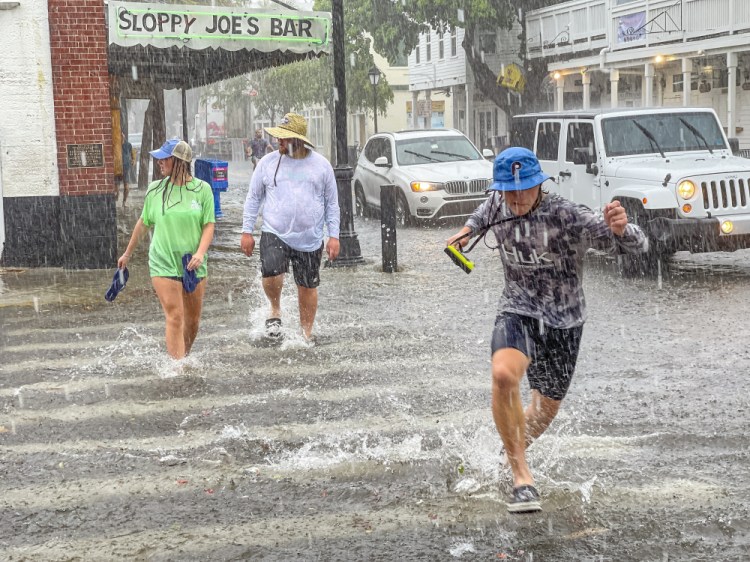ST. PETERSBURG, Fla. — A weakened Tropical Storm Elsa dumped rain across Florida’s northern Gulf Coast early Wednesday but spared the state significant damage as it headed northward.
Elsa wobbled through the Gulf of Mexico, briefly reaching hurricane strength, but moved ashore as a tropical storm, the U.S. National Hurricane Center said Wednesday in its 11 a.m. advisory. The storm made landfall in lightly populated Taylor County, Florida, with maximum sustained winds clocking 65 mph (105 kph).
Gov. Ron DeSantis said at a morning news conference that no major structural damage or deaths from the storm had been reported.
“Clearly, this could have been worse,” the Republican governor said, adding that many storm-related deaths come after the system passes. “Be very careful when you’re working to clear debris.”
Tropical storm warnings were canceled for Cape Coral and Fort Myers. Further north, the Tampa Bay metropolitan area — while wet and windy — appears to have emerged mostly unscathed. Tampa was no longer under a hurricane warning, but weather forecasters warned of tropical storm conditions, including strong winds and flash flooding. Tornado watches were also in effect in some areas.
DeSantis said there were up to 26,000 customers without power in the region, most of them in Hillsborough, Pinellas and Polk counties that surround Tampa Bay. Crews were working to restore electricity and DeSantis said no hospitals reported an outage, which has been a major problem in past storms.
“We’re fortunate to see minimal damage & flooding this morning, but it’s important to keep safety top of mind. Be aware of your surroundings & don’t drive through flood waters,” Tampa Mayor Jane Castor said via Twitter.

Elsa was forecast to cross from Florida into southeast Georgia on Wednesday afternoon, and the National Hurricane Center issued a tropical storm warning for the state’s entire 100-mile (160-kilometer) coast. Elsa was expected to bring 2 to 4 inches (5 to 10 centimeters) of rain to Georgia as it churns to the northeast before entering South Carolina to the west of Savannah early Thursday. By Friday, the storm’s effects were expected to be felt as far north as New England.
The storm complicated the search for potential survivors and victims in the collapse of a Miami-area condominium on June 24. Despite that challenge, crews continued the search in the rubble of Champlain Towers South in Surfside, Florida, on the state’s southeast coast.
The storm also temporarily halted demolition work Wednesday on the remainder of an overturned cargo ship that’s partially submerged off the coast of Georgia. The South Korean freighter Golden Ray capsized in September 2019 off St. Simons Island, about 70 miles (110 kilometers) south of Savannah. Crews have dismantled and removed more than half the ship since November.
More than 250 workers are assigned to the salvage operation, and most of them were sheltering indoors Wednesday, said Coat Guard Petty Officer 2nd Class Michael Himes, a spokesperson for the multiagency command overseeing the demolition.
The towering crane being used to cut the ship into giant chunks was being kept in place straddling the wreck, stabilized by mooring lines attached to anchors and pilings. The crane was also anchored to the shipwreck itself, which weighs about 13,200 tons (12,000 metric tons), Himes said.
“As far as the wreck shifting, that’s highly unlikely,” Himes said.
He said crews would be watching to see if Elsa’s winds scatter any debris from the ship into the surrounding water. The vessel’s remains are open at both ends, like a giant tube on its side, and its cargo decks still contain hundreds of bashed and mangled cars.
Out on Edisto Beach, South Carolina, where a tropical storm warning was in effect, Wednesday started muggy and overcast.
“The kind of day you can just feel the weather wanting to move in,” Mayor Jane Darby said.
The forecast for the barrier island 30 miles (48 kilometers) down the coast from Charleston was similar to a heavy summer thunderstorm – an inch or two (2.5 to 5 centimeters) of rain, winds gusting up to about 40 mph (64 kph) and maybe a little beach erosion with the worst of Elsa expected between low and high tides. All of South Carolina’s beaches expected about the same conditions, coming mostly overnight to be less of a bother to visitors during an extremely busy summer.
“Businesses are struggling with workers in short supply a lot more than they are going to be bothered by this storm. That’s where the stress is now,” Darby said.
Elsa is already the third tropical system to hit South Carolina. In June, Tropical Storm Claudette moved across the northern part of the state after making landfall in Louisiana and Tropical Storm Danny hit land near Hilton Head Island. Both storms caused only minor damage.
Meanwhile, the U.S. Coast Guard said 13 people were rescued from a boat that had left Cuba with 22 people aboard late Monday. Nine people remained missing.
Elsa is the earliest fifth-named storm on record, said Brian McNoldy, a hurricane researcher at the University of Miami.
Send questions/comments to the editors.



Success. Please wait for the page to reload. If the page does not reload within 5 seconds, please refresh the page.
Enter your email and password to access comments.
Hi, to comment on stories you must . This profile is in addition to your subscription and website login.
Already have a commenting profile? .
Invalid username/password.
Please check your email to confirm and complete your registration.
Only subscribers are eligible to post comments. Please subscribe or login first for digital access. Here’s why.
Use the form below to reset your password. When you've submitted your account email, we will send an email with a reset code.